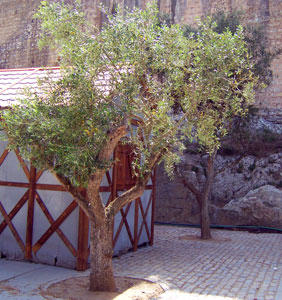Olive
The olive is native to the Mediterranean region, parts of Africa and tropical and central Asia. It is one of the oldest known plants to be used by man.
Olive seeds found in Spain and tested using carbon dating have shown the olive has been domesticated for eight thousand years. The olive was thought to be grown in two separate areas, Crete and Syria, with archeological evidence showing a date of 2,500 B.C. for those grown in Crete. From there they spread to Greece, Rome and other parts of the Mediterranean area.

Olives have been domesticated for over 8000 years
In Spain, the growing and production of olive oil is one of the principal exports, with over six million tons being produced yearly? The growth of the olive in the New World was thought to be from 1769 with the planting of seeds from Mexico to what is now California.
The olive tree is an evergreen shrub that grows from eight to fifteen meters, with grayish green feathery looking leaves and gnarled rough bark. The flowers are cream white and there are two different types. One has both male and female parts and the other just the flower with staminate only.

Olives are not always easy to grow
Olive trees start to bear fruit when they are over four years of age. Pruning may be needed to keep the tree healthy and at a height suitable for easy harvesting. The fruit of the olive is green when it first grows gradually changing to a dark purple black color when ripe.
The olive has problems with pests including the olive fruit fly and med fly, and in California the spread of vinculum fungus by using infected tools is a problem. They are usually not sprayed because the oil of the olive retains taste of the insecticide.
Historical references to the olive abound with the most famous being that of Jesus in the Garden of Gethsemane, the name comes from the Hebrew name for olive press. Pliny the elder mentions it as being one of the oldest trees, over 1,600 years old.
The use of the olive as food is well documented. Raw olives are bitter so they have to be fermented or soaked in brine to make them palatable. Iberian olives are cured and pitted, then stuffed with onions or pimentos and soaked in brine.
Olive oil is used in massage therapy, as carrier oil for the other essential oils from herbs.
Home remedies claim that olive oil is a good tonic for the body when taken orally.



